Throughout the history of dentistry and orthodontics, improving treatment and chairside efficiency has been a common goal. Artificial intelligence in orthodontics has achieved big progress recently.
For the advancement of new technologies and scientific research, have been the main catalysts. In many ways, the use of AI in digital orthodontics is the achievement of this objective, and more than just the newest fad, in my opinion, it represents the direction of our sector.
Table of Contents
The Rise and Use of AI
Generally speaking, technology is created to make our lives easier. It enables us to finish tasks faster while also doing them more precisely and effectively. The development of teledentistry has enabled us to treat our patients more effectively and has revolutionized the practice of dentistry worldwide, much like how Google Maps made navigation (almost) foolproof and email rendered letters obsolete.
Big data and AI use is the most recent trend that has spread throughout the medical sector and is at the heart of numerous new technologies for the detection, treatment, and monitoring of a variety of diseases and conditions. For dentists like us, this necessitates a mental shift away from an obsession with appliances and toward the adoption of AI and automation.
Related Reading: Artificial Intelligence Pros And Cons
AI and Orthodontic Care
Huge changes in our profession have occurred over the last few decades. With the introduction of new, more aesthetically pleasing orthodontic treatment options, the move to a fully digital workflow, the emergence of temporary anchorage devices, and new imaging techniques, orthodontic care is now more patient- and professional-centered.
The application of artificial intelligence (AI) in orthodontics has significantly increased over the past few years in order to improve the diagnostic process’ accuracy and effectiveness. For predicting treatment prognosis, this information is essential. However, the addition of this AI-based knowledge does not change the fact that the best diagnosis and treatment strategy are ultimately determined by the healthcare professionals with their own knowledge acquired through specialized training and years of experience. However, when making specific clinical decisions in a constrained amount of time, AI can be helpful. Because AI applications produce highly accurate results, they can sometimes help clinicians avoid human errors by guiding them to make better decisions and perform better.

To appreciate the impact of AI on orthodontics, it is first important to discern some key terms related to AI:
- The primary goal of AI is to give a machine the capacity for autonomous intelligence. In other words, AI aims to make a machine capable of learning from data and resolving issues on its own.
- The main support system for AI is machine learning (ML). It incorporates ideas from numerous research fields and relies on algorithms to forecast outcomes based on data sets. Its goal is to make it easier for machines to learn from data and solve problems on their own. The support vector machine (SVM), logistic regression (LR), naive Bayesian classifier, decision tree (DT), random forest (RF), extreme learning machine (ELM), fuzzy k-nearest neighbor (FKNN), and convolution neural network (CNN) are some of the most widely used machine learning (ML) techniques.
- Neural networks are a collection of algorithms that process signals through synthetic neurons that mimic the way human neurons function.
- ML is not complete without deep learning. To analyze input data, it employs deep neural networks, which use networks with various computer layers. Its goal is to create a neural network that has automatic pattern recognition capabilities to enhance feature detection.
- Big data is the term used to describe large data sets and/or the combination of all data points available from various sources that can be used to identify patterns and create personalized experiences for various users.
The average orthodontic treatment lasts nearly 29 months, so orthodontists must become more effective if they are to meet society’s demands. The use of ML methods can assist in finding a solution to this problem.
Recent advancements in orthodontic technology, such as cone beam computed tomography (CBCT) and 3D visualizations, intraoral scanners, facial scanners, instant teeth modeling software capabilities, and new robotic and 3D-printed appliance developments, are rapidly transforming medical care. These tools make it possible to create dynamic anatomical reconstructions for the particular patient and provide a better understanding of the patient’s anatomy, opening up the possibility of 3D treatment planning.
Convolutional neural networks (CNNs) are increasingly used for medical image diagnosis, most frequently for the detection, segmentation, or classification of anatomical structures. Geometric feature learning and classification have recently both benefited from deep learning. Data-driven decision-making is made easier by using machine-learning approaches, which are algorithms trained to find patterns in large data sets.
This scoping review aims to identify the applications of artificial intelligence (AI) that are frequently used in the field of orthodontics, to assess the advantages of AI, and to discuss its potential implications in this specialty.
Read More:
Materials and Methods
Below are some methods used now.
Protocol
The Preferred Reporting Items for Systematic Reviews and Meta-Analyses Extension for Scoping Reviews (PRISMA-ScR) guidelines were followed when conducting this review. The study protocol was created after running a pilot search through PubMed on MEDLINE. The initial outcomes of the pilot search were used to construct the data extraction forms.
Literature Search
Between November 2020 and March 2021, a search of the electronic literature was conducted using the MEDLINE/PubMed, Scopus, Web of Science, Cochrane, and IEEE Xplore databases.
To complete a precise and repeatable search, a particular word combination was added. Additional manual searches weren’t carried out.
Eligibility Criteria
On the basis of their title and abstract, search engine results were initially assessed for relevance. Studies that contained information not related to the study question in their titles or abstracts were excluded. To make sure the review was based on the most recent data, an 11-year restriction was decided upon, running from January 2010 to March 2021. We only took into account fully accessible articles. Included were articles on artificial intelligence in the field of orthodontics. Only publications with sufficient documentation of the data sets they used and those that used some predictive measurable outcomes, such as accuracy, sensitivity, and specificity, were taken into consideration. To ascertain their eligibility, the full texts of all pertinent publications and studies whose abstracts lacked sufficient details to support an exclusion decision were acquired. Studies pertaining to subjects other than artificial intelligence (AI) and articles written in any language other than English, Spanish, Portuguese, Italian, German, or French were also disqualified.
Results Extraction
The articles were mined for information on the type of ML technique, the quantity and variety of images used to test AI software, the precision of the technique, and its advantages for the orthodontics field.
Benefits for the Dentist, and the Patient
Although the body of research on the use of remote monitoring and DM is still in its infancy, early research and anecdotal evidence strongly suggest that the use of AI technology can have positive effects on both patients and dentists.
Reduction in Unnecessary & Total Appointments
The ability of AI technology to reduce both unnecessary and overall appointments throughout a treatment period has been demonstrated in numerous studies.
Remote teledentistry may play a significant role in lowering the rate of inappropriate referrals, according to research. Due to the ability to prescreen patients and assess their progress before requesting an appointment, I have seen a significant decrease in the number of unnecessary appointments in my own practice.
Therefore, it makes sense that fewer unnecessary appointments would result in fewer overall appointments over the course of treatment. This theory was initially supported by research and more recently confirmed by a peer-reviewed study conducted in 2020, which revealed a reduction of 3.5 visits (33.1% fewer visits) for patients who used DM as part of their treatment plan compared to a control group who did not, with no clinically significant reduction difference in total visits.
This not only demonstrates how AI can improve chairside and treatment efficiency, but it also raises the possibility that it can decrease societal costs and patient inconvenience, leading to an uptick in patient satisfaction.
Increased Compliance & Improved Hygiene
We recently covered some of the more widespread difficulties that dentists and orthodontists encounter when it comes to patient compliance. In particular, DM and AI can be an effective tool for assessing patients, prescribing treatments, and addressing low compliance, which is a problem in younger populations in general.
According to the Hawthorne Effect, people may alter a behavior pattern when they become aware that they are being watched. Meaning that frequent observations will probably lead to higher compliance in a clinical setting.
An increase in compliance for the recommended aligner wear time from 70% to 95% was found in internal research carried out at the CCC Smiles Orthodontics practice. As we know, this is likely to have a significant effect on treatment efficacy.
Furthermore, numerous studies have demonstrated that AIRM increased compliance with oral hygiene standards, possibly in part as a result of the Hawthorne effect but also as a result of active reminders provided by DM technology to both the dentist and patient.
In addition to helping with the implementation of the specific treatment, increased compliance and better oral hygiene also benefit the patient’s overall, long-term oral health.
Greater Treatment Flexibility & Easier Communication
It has never been more crucial to be able to treat patients and communicate with them in a flexible way than it is right now.
Anecdotal research conducted prior to the COVID-19 pandemic highlighted the scope and potential of remote monitoring in situations where physical appointments were impractical. This theory has since been confirmed by the pandemic.
Unexpectedly, remote monitoring has also been shown to improve patient and clinician communication. enabling the doctor to keep a closer eye on the patient and speak up when necessary.
Regardless of the particular situation, the ability to efficiently and effectively track patients’ progress and communicate with them directly naturally reduces the need for and dependence on in-person meetings, opening the door to more flexible treatment options in the future.
Conclusions
The reviewed studies showed how CNNs could be used to automatically identify anatomical reference points on radiological images. The CVM can be calculated using an ANN model for growth and development areas and produce results that are identical to those of human observers.
Orthodontists can work more effectively by using AI technology to increase the accuracy of diagnoses for orthodontic treatment.
Orthodontists and other healthcare professionals will undoubtedly benefit greatly from advances in AI, but the ultimate authority in health decisions will always rest with clinicians.
Read More:




